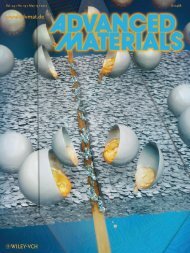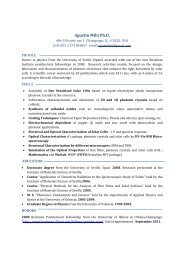Polymer Brushes for Molecular Transport - Paul Braun Research ...
Polymer Brushes for Molecular Transport - Paul Braun Research ...
Polymer Brushes for Molecular Transport - Paul Braun Research ...
You also want an ePaper? Increase the reach of your titles
YUMPU automatically turns print PDFs into web optimized ePapers that Google loves.
PNIPAAm, though thin, may still allow <strong>for</strong> fast (relative to bulk) surface diffusion. Thus,<br />
fluorescence would recover in the seemingly isolated PNIPAAm squares just as easily as it<br />
recovered on unpatterned surfaces as is observed experimentally.<br />
3.5 Conclusions<br />
In conclusion, we have demonstrated a facile route <strong>for</strong> <strong>for</strong>ming patterned PNIPAAm<br />
brushes on oxide surfaces by microcontact printing of a surface initiator followed by the surface<br />
initiated ATRP of NIPAAm. The patterning of the surface initiator was achieved by<br />
microcontact printing octadecyltrichlorosilane followed by backfilling<br />
aminopropyltriethoxysilane onto the unprinted region. The amino group was subsequently<br />
reacted with bromoisobutyric acid <strong>for</strong>ming the surface-grafted initiator. The surface-initiated<br />
ATRP of NIPAAm was then carried out. The chemical structure of the PNIPAAm brushes was<br />
confirmed by XPS and FT-IR, and the physical properties were characterized with ellipsometry,<br />
contact angle measurements, and XRR. AFM confirmed successful micropatterning of the<br />
PNIPAAm brushes. Environmental ellipsometry measurements showed that the LCST transition<br />
of the PNIPAAm brush occurs over a broad temperature range of 20 to 35 °C. The fluorescence<br />
emission spectra of Prodan in PNIPAAm brushes indicated that the local chemical environment<br />
of the PNIPAAm is very similar to that of DMF. In addition, fluorescence microscopy suggested<br />
that Prodan is localized in the patterned PNIPAAm brushes and excluded from the OTS regions.<br />
The FRAP results of Prodan on PNIPAAm layers indicate that bulk translational diffusion, if<br />
any is taking place, is at best very slow relative to other diffusion mechanisms. Isolating squares<br />
of PNIPAAm brush with printed OTS lines does not eliminate the fluorescence recovery after<br />
photobleaching entire isolated squares. Possible explanations <strong>for</strong> the fluorescence recovery<br />
52




